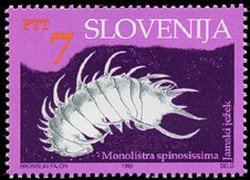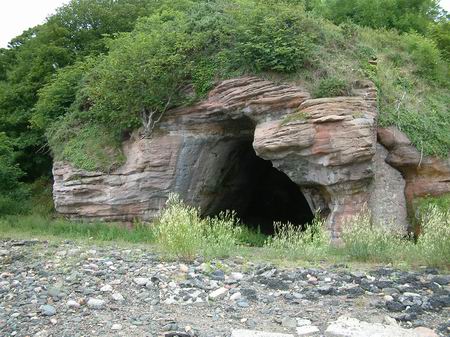Stamp: Cave animals - The long-spined cave isopod crustacean (Slovenia 1993)
Cave animals - The long-spined cave isopod crustacean (Slovenia 1993)
12 July (Slovenia ) within release Cave animals goes into circulation Stamp Cave animals - The long-spined cave isopod crustacean face value 7 Slovenian tolar
| Stamp Cave animals - The long-spined cave isopod crustacean in catalogues | |
|---|---|
| Michel: | Mi:SI 60 |
Stamp is horizontal format.
Also in the issue Cave animals:
- Stamp - Cave animals - The long-spined cave isopod crustacean face value 7;
- Stamp - Cave animals - Cave beetle face value 40;
- Stamp - Cave animals - European cave salamander face value 55;
- Stamp - Cave animals - Cave snail face value 60;
- First Day Cover - Cave animals face value 167;
Stamp Cave animals - The long-spined cave isopod crustacean it reflects the thematic directions:
Beetles are insects that form the order Coleoptera (/koʊliːˈɒptərə/), in the superorder Holometabola. Their front pair of wings are hardened into wing-cases, elytra, distinguishing them from most other insects. The Coleoptera, with about 400,000 described species, is the largest of all orders, constituting almost 40% of described insects and 25% of all known animal species; new species are discovered frequently, with estimates suggesting that there are between 0.9 and 2.1 million total species. Found in almost every habitat except the sea and the polar regions, they interact with their ecosystems in several ways: beetles often feed on plants and fungi, break down animal and plant debris, and eat other invertebrates. Some species are serious agricultural pests, such as the Colorado potato beetle, while others such as Coccinellidae (ladybirds or ladybugs) eat aphids, scale insects, thrips, and other plant-sucking insects that damage crops. Some others also have unique characteristics, such as the common eastern firefly, which uses a light-emitting organ for mating and communication purposes
A cave or cavern is a natural void in the ground, specifically a space large enough for a human to enter. Caves often form by the weathering of rock and often extend deep underground. The word cave can refer to smaller openings such as sea caves, rock shelters, and grottos, that extend a relatively short distance into the rock and they are called exogene caves. Caves which extend further underground than the opening is wide are called endogene caves


